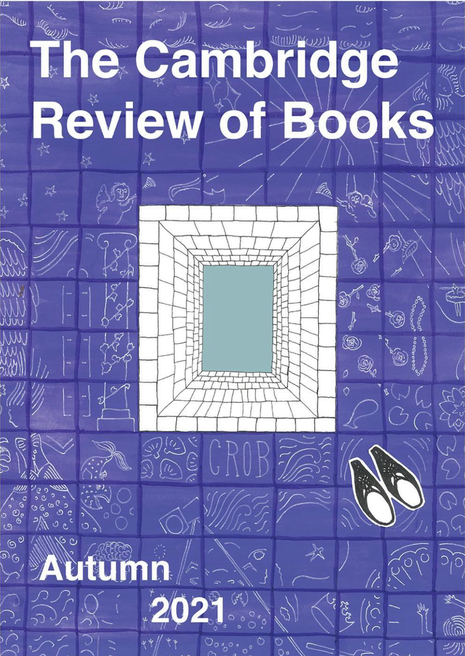Changing with the Seasons: The Cambridge Review of Books
Deputy Vulture Editor Margherita Volpato ends this term with a look at the latest issue of the ‘Cambridge Review of Books’

Hidden within the pages of the Cambridge Review of Books’ latest issue is the very essence of autumn. Its pages are atmospheric and its writing euphoric. There are moments of coldness that invite readers to lounge with a warm cup of tea, now that our break has, for most, finally arrived. I couldn’t help but be incredibly impressed with the writing I found within its pages. Not to mention the designs – by Marion Willingham, which at this point are just further examples of the high quality of the zine – of this year’s Autumn issue, which beautifully accompanied every piece, offering visual perspectives and interpretations, alongside these astoundingly complex pieces. The illustrations and cover, too, speak of winter’s incoming influence, described in cool blue and bare textured sketches, and together they help to complete the atmosphere that comes alive within these pages.
“Its pages are atmospheric and its writing euphoric”
Perhaps one of the reasons why I found this atmosphere so pervasive was because of the palpable nostalgia in some of the prose and essay pieces throughout. In Rosa Phelps’ ‘Place and Cinema’, about Andrzej Wadja’s The Promised Land (1975) and its setting in Łódź, Poland, I was moved – her childhood memories were explained cinematographically and it made me think of how I picture my childhood. How it too can be cut up and edited in places, rather than age or years. Her brilliant balancing of personal and academic writing was refreshing, for someone stuffed to the brim with academic writing this term and very ready for a break, I was intrigued until the very end. She made me reconsider so many things: my childhood in Greenwich, where so many period movies are filmed, and how much I resonated with her when she writes ‘all places are layered with story upon story, gaze upon gaze, depending on who is looking, and when.’
I felt a similar nostalgia in ‘Tutu’ by Juliet Gueron-Gabrielle, an excellent experimental piece trying to balance the past with present emotions; in ‘Ingrid at the Ballet’, by Isabella Fox, I very nearly shed a tear (yes, I am an emotional reader), with its stunning visualisations of motherhood and the past; in ‘Moving Pictures’, by an anonymous contributor, there was an equally powerful movement of time. All of these works felt packed with the homey feelings winter incites in me, and the nostalgia that holidays with the family, followed right after by the end of another year, always enflames.
“Thank you to all of its contributors for what they have written”
The stars of this issue were undoubtedly the translations, a new addition to CRoB. Both were beautifully prefaced by Magdalena Gabrysiak, Head of Editorial, to explain why she wanted to include them, alongside some relevant context. Henry Woodland’s translation, for me, created a scintillating mesh of form and content, to create some seriously intense Divagations. I felt as though he and Stéphane Mallarmé were in conversation. The same can be said about Joshua Clayton’s translation of Rainer Maria Rilke’s Duino Elegies: in fact, they were incredible. The choice of words, the sounds, the rhythm – honestly, Joshua could not have made it harder for an English student like me to not want to engage critically with his translation. To both, I bestowed the greatest honour: I read them out loud, twice. To anyone interested in translation, how one is credited for changing another’s words to another language, for balancing influence and originality, or in the transfer of meaning, I suggest you read these two translations and all the paratextual information that the CRoB provides. Their thinking is current and important, and I was thoroughly impressed.
As always, the essays in the CRoB are outstanding. As one of the larger zines in the scene, least of all for its A4 size, it can afford to give space to these great examples of thinking which, as always, made consider new concepts in new ways. Matilda Sidel’s ‘Unpicking the Ick’ seemed like an answer from the heavens for all of us confused about the mysterious (and yet annoyingly real) ‘ick’. She will navigate it for you confidently, clearly and, honestly, just brilliantly. The days of Buzzfeed articles are gone because here is some real writing on that female urge of the ‘ick’. Srinidhi Balakrishnan’s essay on Yorkshire through David Hockney’s eyes was equally stunning, packed with so much nature it made me miss springtime. One should also mention Stanley Lawson’s ‘The Many Afterlives of Edward II’. Not going to lie, the title is intimidating; but, Stanley takes his readers to unexpected, new and incredibly interesting locations. As always, three pages fly by.
For fear of spoiling too much about the splendours that hide within its pages, my review of the CRoB must end here. Please know that whatever I have not mention outright here, in this tiny review, is very much worth a read. For fear of sounding like a broken record I will only say it once more: everything the CRoB has to offer in this issue is powerful, insightful and beautiful. Thank you to all of its contributors for what they have written.
If you are at all interested in joining the ‘Cambridge Review of Books’ check out their Facebook page to join their team.
 News / Clare Hall spent over £500k opposing busway 24 December 2025
News / Clare Hall spent over £500k opposing busway 24 December 2025 Comment / The ‘class’ of Cambridge24 December 2025
Comment / The ‘class’ of Cambridge24 December 2025 News / Caius mourns its tree-mendous loss23 December 2025
News / Caius mourns its tree-mendous loss23 December 2025 Comment / Yes, I’m brown – but I have more important things to say22 December 2025
Comment / Yes, I’m brown – but I have more important things to say22 December 2025 News / Girton JCR publishes open letter expressing solidarity with Palestine25 December 2025
News / Girton JCR publishes open letter expressing solidarity with Palestine25 December 2025










